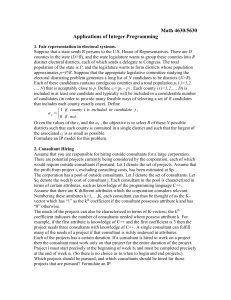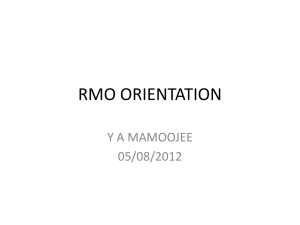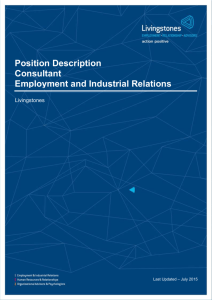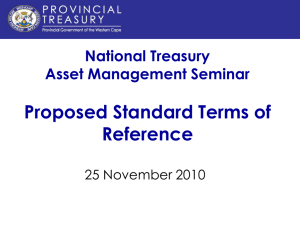BRIDGE Report Gene Kutcher, HRM 315: Employee Selection
advertisement
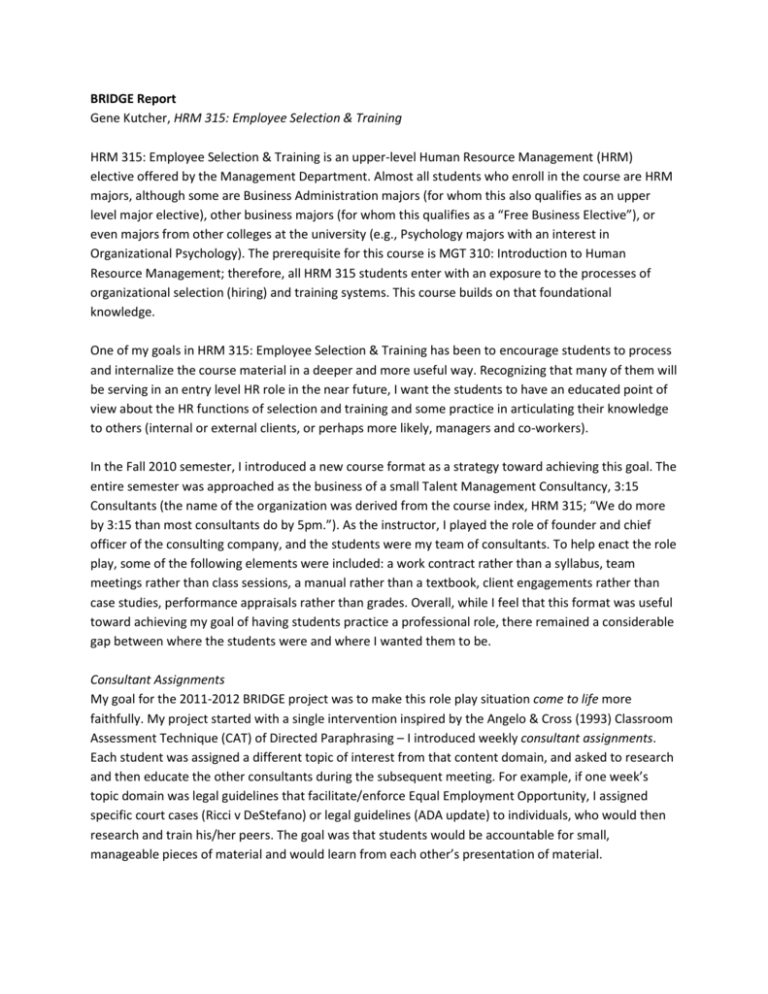
BRIDGE Report Gene Kutcher, HRM 315: Employee Selection & Training HRM 315: Employee Selection & Training is an upper-level Human Resource Management (HRM) elective offered by the Management Department. Almost all students who enroll in the course are HRM majors, although some are Business Administration majors (for whom this also qualifies as an upper level major elective), other business majors (for whom this qualifies as a “Free Business Elective”), or even majors from other colleges at the university (e.g., Psychology majors with an interest in Organizational Psychology). The prerequisite for this course is MGT 310: Introduction to Human Resource Management; therefore, all HRM 315 students enter with an exposure to the processes of organizational selection (hiring) and training systems. This course builds on that foundational knowledge. One of my goals in HRM 315: Employee Selection & Training has been to encourage students to process and internalize the course material in a deeper and more useful way. Recognizing that many of them will be serving in an entry level HR role in the near future, I want the students to have an educated point of view about the HR functions of selection and training and some practice in articulating their knowledge to others (internal or external clients, or perhaps more likely, managers and co-workers). In the Fall 2010 semester, I introduced a new course format as a strategy toward achieving this goal. The entire semester was approached as the business of a small Talent Management Consultancy, 3:15 Consultants (the name of the organization was derived from the course index, HRM 315; “We do more by 3:15 than most consultants do by 5pm.”). As the instructor, I played the role of founder and chief officer of the consulting company, and the students were my team of consultants. To help enact the role play, some of the following elements were included: a work contract rather than a syllabus, team meetings rather than class sessions, a manual rather than a textbook, client engagements rather than case studies, performance appraisals rather than grades. Overall, while I feel that this format was useful toward achieving my goal of having students practice a professional role, there remained a considerable gap between where the students were and where I wanted them to be. Consultant Assignments My goal for the 2011-2012 BRIDGE project was to make this role play situation come to life more faithfully. My project started with a single intervention inspired by the Angelo & Cross (1993) Classroom Assessment Technique (CAT) of Directed Paraphrasing – I introduced weekly consultant assignments. Each student was assigned a different topic of interest from that content domain, and asked to research and then educate the other consultants during the subsequent meeting. For example, if one week’s topic domain was legal guidelines that facilitate/enforce Equal Employment Opportunity, I assigned specific court cases (Ricci v DeStefano) or legal guidelines (ADA update) to individuals, who would then research and train his/her peers. The goal was that students would be accountable for small, manageable pieces of material and would learn from each other’s presentation of material. In implementing this activity, it became clear that the students – while technically following my instructions – were still acting like students and not like professionals. For example, they were reading their prepared responses from their notes, they were presenting their research with a tentative and detached style, they were sharing at either an overly shallow or detailed level of information, etc. Basically, I was not feeling that the desired consultant meeting format was coming to life. I employed a few different strategies to improve this performance. First, I tried to model what I was seeking in their professional behavior. To this end, I would briefly report the sources where I found the information, summarize the given topic in no more than one sentence, and then use a few more sentences to clarify or explain what I meant in my summary sentence. I would make eye contact with the consultants and, when I was finished, ask if they understood or would like to ask me any questions. Second, I provided a non-example myself (this suggestion was offered by a BRIDGE colleague). Because I am the instructor of the course, and they are used to seeing me try to implement positive teaching behaviors on a regular basis, I wanted to give an example of how my input would appear if I were not reflecting the approach outlined above. Here, I looked down at my paper throughout my summary, I appeared uncomfortable with the text I was reading (mispronouncing words or using comments like “I’m not sure what this means but…”), and I used a weaker vocal pattern (tonally ending sentences as if I were asking questions rather than declaring ideas). The third and perhaps most effective approach involved some rubric-building with the class. In the course, we cover the importance of thorough Job Analysis as a way to document the Knowledge, Skills, and Abilities (KSAs) of incumbents in any job function. I led the class in a Job Analysis of a customer service representative (a close relative of the professional services consultant). As an output from this discussion, I devised a quick and dirty set of criteria that would be used to evaluate future consultant work in our weekly meetings. That is, consultants would be expected to be Accurate, Confident, Concise, and Appropriate. In the rubric below, “NI” stands for “needs improvement,” “S” stands for “Satisfactory” and “E” stands for “Excellent.” Presents information … … accurately (technically correct information) … confidently (ownership, authority, enthusiasm) … concisely (neither incomplete nor too much information) … appropriately (considering audience and his/her needs) NI S E During subsequent class sessions, I would stop intermittently after particularly effective consultant updates and indicate how the consultant achieved each of the four criteria. For example, I would say that the consultant appeared to be confident because he/she made eye contact with the other consultants, referred to – but was not reading from – his/her notes, and used his/her own language to describe the content area. I feel that this light rubric was effective because the students were, in a sense, committed to its validity (after all, they, in a sense, authored it). I believe that by making these desired behaviors explicit and a topic of critique, this effectively changed the standard by which students were extending effort into their class performance. In the second half of the course (the Training in “Employee Selection & Training), I did try a strategy for engaging the consultants further in each other’s consultant reports. Initially, the assumption was that not every student needs to do all of the background reading; instead, the students would be learning from each other. However, the less effective the students were in presenting their consultant projects, the less their colleagues appeared to be attending and learning. To motivate the consultants to be attending to each other, I instituted a summary activity. After a consultant reported about a topic (e.g., Kirkpatrick’s Taxonomy of Training Evaluation), I asked another consultant to rephrase it in just one sentence (similar to what Angelo & Cross, 1993, would call a One-Sentence Summary). The outcome was a single handout that captured these one-sentence summaries. This handout was then used as a job aid for the consultants when taking the end-of-session exam (more on that below under the Exams section). Before leaving the management of the consultant tasks, it is worth noting that I have identified some opportunities to further enhance this activity in the future. First, a BRIDGE colleague suggested that I could film effective consultant reports and share that with consultants (perhaps on our Blackboard site and perhaps as a living example of training self study; it could fit nicely as a demonstration of pre work in a training model, which itself relates to the course content). Second, as another method for engaging the other consultants when one consultant was presenting, a suggestion from a BRIDGE meeting was to change the roles of the other consultants. Rather than encouraging the other consultants to act as fellow consultants, they could be instructed to act as the client (or, fellow consultants posing as clients). In essence, this would become a role play within a role play. Again, this could be addressed with a pre-course training experience for the students that teaches them how to be consultant and how to be effective peers. While the BRIDGE project started as simply incorporating the consultant tasks, my larger goal became to remain steadfastly faithful to the consulting company role play. Another component of the course that I re-tooled was the exams. Exams The exams were presented in the course structure as consultant knowledge tests. It was explained that there would be too much risk in allowing our consultants to service clients without a documented mastery of the subject matter about which they were advising. In response to material that was discussed in BRIDGE, I reduced the number of multiple choice questions from 25 down to 12. I believe that these 12 questions are bits of declarative knowledge that are indicative of becoming an expert in the field. Furthermore, all exam items (both multiple choice and open-ended) were posed as clientgenerated questions (e.g., a client wants to know x, how would you respond?) or applications or interpretations of data. These questions more closely match the format and level of complexity (i.e., Bloom’s Taxonomy) of how we discuss information during the class sessions themselves. I also introduced the concept of job aids as tools to be used during the knowledge tests. In our course readings about maximizing the chances that training material would ultimately be applied on the job, we discussed the power of Job Aids. These are any tools that can be used in a just-in-time fashion to aid in the recall of previously acquired information and have direct relevance to current problem solving. The first half of the course is about Employee Selection, and as required reading, students are instructed to complete a practitioner-facing self-study online course on proper employee interviewing. As part of this training program, there are several job aids provided to learners. I allowed students to print and bring these job aids with them to the exam. In the second half (Training), consultants were allowed to bring the collection of one-sentence summaries. In both cases, I feel that this policy helped the students acquire the material and believe in their own efficacy. In fact, for students to be able to use the available job aids during the exam itself, they would need to be knowledgeable about the purposes of the information. As argued in Hirsch (2000), for example, even the act of “looking up” information to answer a question requires some knowledge or base of expertise. The application nature of the client inquiry exam items, plus the reference format of the available job aids, is consistent with the goal of the course – to prepare students to be professionals in the workplace, using their coursework to solve real-life business problems. In fact, post-hoc feedback from students demonstrated that even on the exams, sometimes they felt as though they were actually working on true client engagements more than taking a test. Future Revisions I will continue to work toward the course’s complete immersion in the role play dynamic. Some of the revisions that I am considering, which have been inspired from BRIDGE participation, include the following: Readings – diversify the readings that are being provided. I currently draw from two different textbooks. In the future, I think I would incorporate readings from other sources. Ideally, these sources would be a variety of practitioner-facing, scholarly, and research-based articles. Consultant Training – above, I mention that it may be worthwhile to more fully orient the students to their role as consultant. I may, at least, find some readings about the skill sets of effective consultants and start the course with a discussion about the proper selection and development of HR consultants. Organization – On the first day of class (i.e., our employee orientation), I administer a knowledge test to determine the retained knowledge from the prerequisite course. I then use those test scores, along with other factors such as self-reported confidence with the content areas, work experience in the content areas, etc., to assign individuals to different project groups (so that each of the groups is assigned a high scorer, an experienced professional, etc.). I may consider assigning group leaders to be lead consultants on the project teams. Infusing some hierarchy may appeal to a competitive spirit, influence student engagement, and provide structure to consultant group work. Consultant Feedback – One thing that I did more formally in the past was deliver a performance appraisal. I would like to revive this in the upcoming version of the course, where each consultant is given his/her scores against the rubric given above, along with test and project scores and qualitative feedback. I may provide a mechanism, as well, for consultants to share feedback with each other. My objective was to provide a context where students are learning new information, finding the practical applications of that information, and practicing the persona of a knowledgeable professional. I feel that interventions described above have been successful in motivating and challenging the students to honor the role play format. I look forward to implementing some of the other enhancements in future iterations of the course. References Angelo, T.A. & Cross, K.P. (1993). Classroom Assessment Techniques: A handbook for college teachers. San Francisco, CA: Jossey-Bass. Hirsch, E.D. (2000). You can always look it up…or can you? American Educator, 2, 1-5.
